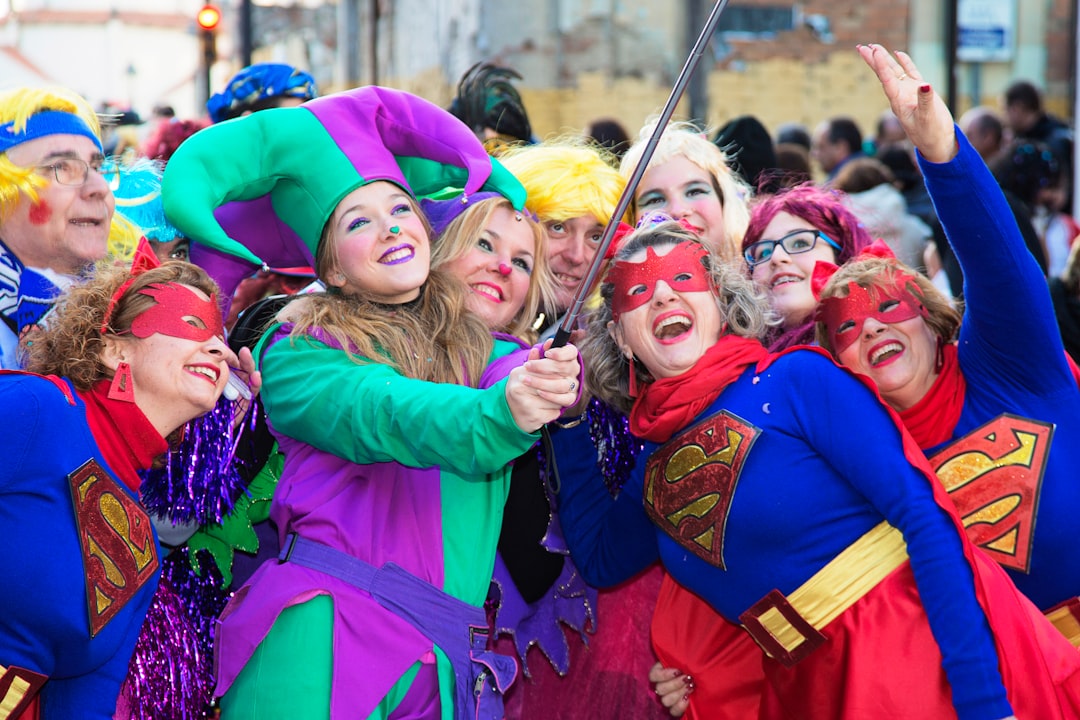

Engage prospects with a scan and streamline customer engagement with FREE QR code marketing tools by Sona – no strings attached!
Create a Free QR CodeFree consultation

No commitment

Engage prospects with a scan and streamline customer engagement with FREE QR code marketing tools by Sona – no strings attached!
Create a Free QR CodeFree consultation

No commitment
Carnivals thrive on energy, spectacle, and surprise, yet much of that momentum is lost without a reliable way to connect each moment to a measurable action. QR codes solve that problem by turning every poster, wristband, ticket, or ride sign into a smart entry point that invites attendees to engage, respond, and return. Instead of hoping attendees remember a URL or fill out paper forms later, you can capture interest at the exact moment it happens and channel it to the best next step: a map, a game, a coupon, or a registration form.
This shift replaces outdated routines. Paper tickets, static flyers, and manual sign-up sheets give way to digital check-ins, mobile forms, and interactive content that attendees can access right from their phones. The result is smoother crowd flow, faster information sharing, and richer data collection for organizers who need to understand what works and improve quickly.
Modern QR platforms enable teams to orchestrate the entire experience from a single dashboard while collecting data that fuels future growth. Consider the following capabilities that make QR a high-impact tool across an entire carnival:
Once deployed, every scan can drive value beyond the moment. A family who scans to find the children’s area can be invited to vote for next year’s attractions. A thrill-seeker who scans at a ride entrance can receive a time-based coupon to try another nearby ride. These micro-conversions compound into a continuous engagement loop that increases satisfaction on-site and boosts return attendance in the months ahead.

Carnival teams often face a visibility gap: plenty of visitors, yet little data about who they are, what drew them in, and what they did next. Without digital touchpoints, organizers cannot reliably attribute outcomes to specific attractions or campaigns. QR codes solve this gap by creating fast, app-free bridges from the physical venue to the digital experience, allowing you to meet attendees where they are and guide them to what they need.
Speed and simplicity are essential. Nobody wants to download a special app just to view a schedule, enter a contest, or access a coupon. A QR code reduces friction to a single scan, which means more people participate, and each action can be captured and analyzed. This ease of use is especially important at carnivals where guests are moving quickly and attention is scarce.
The power of QR codes for carnivals becomes obvious when you map them to common materials and moments across the event:
By layering QR codes into your operational plan, you gain live insight into audience behavior and create quick paths to value for attendees. This data-driven approach reduces guesswork, focuses resources where they matter most, and positions your carnival for sustainable growth year after year.

Carnivals benefit from several QR code formats, each aligned to a specific outcome. Choosing the right format ensures guests get exactly what they need with minimal friction, while organizers collect the right level of data and control.
Start with formats that match the interactions you want to encourage, then map each format to a best-fit destination. From there, use dynamic codes for any campaign you might want to update or measure in detail.
For destinations, prioritize clear, mobile-optimized pages that load fast and explain the benefit upfront. When in doubt, start with web links and forms, then layer in Wi-Fi, vCards, and app downloads for specific journeys such as VIP hospitality or vendor coordination. With Sona QR, you can generate all of these formats, manage them centrally, and switch destinations on the fly if priorities change.

Growth at carnivals depends on converting high-energy moments into measurable actions. The best opportunities often appear in places you already invest in, such as entrance gates, food lines, ride queues, and performance stages. QR codes multiply the value of those touchpoints by letting people act in real time while giving you full visibility into what resonates.
Look across the attendee journey from arrival to exit. Identify friction points that slow guests down or moments where interest spikes. Then place clear, benefit-driven QR codes that relieve the friction or capture the interest before it fades.
Each placement turns an ephemeral moment into a measurable step in a journey. Over a weekend-long event, even modest improvements in scan-to-action rates can lead to significant growth in opt-ins, sales, and post-event conversions.

Carnivals are at their best when guests move freely between discovery and delight. QR codes help sustain this by creating a rhythm of micro-engagements that turn curiosity into action. The following use cases are proven ways to capture attention and build long-term value.
When implemented using dynamic, trackable QR codes, these use cases can deliver measurable lifts in engagement. Many carnivals observe 15 to 40 percent scan-to-action rates on well-placed QR signage and meaningful increases in post-event email list growth driven by on-site opt-ins.
Every scan tells a story about intent. See Sona intent guide. Someone who scans a code at a high-thrill ride has different interests than a parent scanning at the children’s area. When you attach distinct QR codes to each touchpoint and integrate the data with your CRM, those stories become segments you can retarget with precision.
Start by designing a simple tagging framework. Give each code a consistent naming convention for zone, attraction, or intent. Then map each scan to a suitable next step such as an email flow, SMS alert, or custom audience for paid media. This discipline turns casual scans into long-term relationships that convert.
With a segmented audience built from real behavior, you can improve relevance across communications. Conversion rates rise when offers align with demonstrated interests rather than general assumptions.
QR codes act as a connective tissue across marketing and operations. They unify print, social, email, and on-site experiences into a coherent funnel that captures attention, drives action, and records the data you need for attribution. This is especially valuable for carnivals that rely on seasonal bursts of activity and need to maximize each promotional wave.
The goal is consistency. When every channel invites a scan that lands on a mobile-first destination with a clear call to action, you reduce friction and increase participation. Centralize management through a platform like Sona QR so you can update destinations, monitor performance, and sync with your CRM in real time.
By fusing QR across campaigns, you create an experience that feels continuous rather than fragmented. Attendees never need to hunt for the right URL or queue at an information booth, and your team gets a clear picture of what moved the needle.
Even the best ideas fall short without a clear execution plan. Use the following steps to move from concept to launch while maintaining flexibility and measurement at every stage. Each step outlines the decisions that matter most at carnivals, where timing, placement, and context determine success.
Start with the outcome you want to achieve. Carnivals often aim to lift pre-sale tickets, distribute guests more evenly across zones, and capture feedback in the moment. Pick one or two primary outcomes for a campaign rather than trying to do everything at once.
A tight scope makes execution easier and speeds up learning. As you see results, you can expand use cases and add new codes without losing clarity.
Choose the code type that fits your need for flexibility and tracking. Static codes are fine for fixed assets like a PDF map, while dynamic codes are essential for campaigns that change or require analytics.
When in doubt, default to dynamic for anything tied to marketing or operations optimization. Sona QR supports both formats, with robust analytics and integrations for dynamic deployments.
Design has a direct impact on scan rates. People need to see the code, understand the value, and have confidence that it will work. Treat the QR as a call to action with visual hierarchy that favors clarity over decoration.
Run small pilots in a few locations before you scale. Early feedback helps you optimize placement, message, and visual contrast so you avoid underperforming deployments on event day.
Place QR codes where attendees already pause or look for information. Consider traffic patterns, eye height, and crowd density. The right location can double or triple scan rates compared to a similar message in a low-visibility spot.
For off-site promotion, use QR codes on community posters, school flyers, and local business counter cards. Track which placements drive the most qualified interest so you can concentrate spend next time.
Measurement turns engagement into revenue. Monitor scans by location, time, and device. Watch scan-to-action conversion and drop-off. Then adjust calls to action, offers, or placement during the event to improve outcomes.
Optimization is not a one-time task. Treat every code as a learning asset that reveals where attention flows and how to convert it most effectively.
Tracking starts with simple metrics such as scan volume and conversion rates, but the real payoff comes from connecting scans to business outcomes. When your QR platform integrates with your CRM and attribution tools, you can see which actions lead to ticket sales, merchandise purchases, or donation uplifts. This moves QR from a novelty to a core performance channel.
A strong analytics approach follows the entire journey. It links a scan at the ride queue to a coupon redemption, then to an email capture, and finally to a returning ticket purchase. With Sona QR and Sona.com, you can unify these touchpoints into a clear narrative that drives budget decisions and campaign strategy.
Critical measures include:
As you collect more data, establish benchmarks that fit your carnival. For example, you might aim for a 20 percent or higher scan-to-action rate on clear calls to action and a 10 percent conversion from in-venue scans to post-event email opt-ins. These targets help you evaluate performance and prioritize iterative improvements.
Effective QR programs rely on clarity, consistency, and continuous learning. Beyond the foundational steps, several practical tactics can significantly improve scan rates, data quality, and downstream conversions. Aim for simple, memorable calls to action and always design around the moment of use.
Education is part of the job. Many guests will scan readily if they know what they will get. Encourage staff to point out QR-enabled features such as skipping lines, entering contests, or unlocking exclusive content. The promise of immediate value often doubles participation compared to generic “Learn more” messages.
Creative deployment examples can also unlock new value. For instance, add a QR to ride photo claim tickets so guests retrieve digital photos instantly and opt in for future promotions. Or place eco-themed QR codes on recycling stations, inviting guests to complete a green challenge for a small reward while educating them on sustainability initiatives.

Carnivals have evolved from purely analog spectacles to blended experiences where physical and digital moments enhance one another. What used to be a black box of anonymous attendance is now a measurable journey with clear signals at every turn. The rise of QR codes reflects this shift, providing organizers with the tools to react in real time and to learn from each interaction.
Industry observers report consistent gains when QR is integrated into the attendee journey rather than added as an afterthought. Programs that link codes to meaningful benefits such as skipping lines, getting exclusive content, or claiming time-limited offers tend to perform significantly better than generic “visit our website” prompts. Success is about specificity, placement, and proof of value.
Looking ahead, carnivals that embrace QR as part of a connected data strategy will be positioned to lead. Personalization will go from optional to expected. Attendees will anticipate dynamic updates, real-time perks, and digital souvenirs they can share. QR codes will continue to be the most accessible bridge to deliver that experience without forcing app downloads or complex setups.
Strategic QR adoption helps carnivals transform transient moments into lasting value. By placing dynamic, trackable codes across the venue and marketing channels, organizers can capture intent, reduce friction, and guide guests to meaningful next steps in seconds. The experience improves for attendees who want convenience and rewards, and the insight improves for teams who need data to plan, optimize, and grow.
The path forward is clear: treat QR codes as core infrastructure. Use them to connect offline experiences to digital actions, to attribute revenue, and to nurture audiences over time. With Sona QR, you can generate and manage codes in minutes, monitor engagement in real time, and sync data to Sona.com for identity resolution and multi-touch attribution. That combination turns every scan into a signal you can act on, ensuring your carnival delivers memorable moments today and measurable growth tomorrow. Start creating QR codes for free: Start creating QR codes for free.
QR codes have revolutionized the carnival industry by turning traditional event engagement into dynamic, measurable interactions. Whether it’s attracting new attendees, enhancing on-site experiences, or capturing valuable visitor data, QR codes streamline connections between carnival-goers and organizers, transforming every touchpoint into an opportunity for meaningful engagement. Imagine instantly knowing which attractions draw the biggest crowds or which promotions lead to ticket sales—empowering you to optimize your carnival’s success in real time.
With Sona QR, creating and managing dynamic, trackable QR codes is effortless. Update campaigns instantly without the need to reprint materials, monitor scan activity live, and link every interaction directly to your revenue goals. No more guesswork—just actionable insights that help you deliver unforgettable carnival experiences while driving growth. Start for free with Sona QR today and turn every scan into excitement, engagement, and increased attendance.
QR codes turn physical materials like posters, wristbands, and tickets into interactive entry points that provide instant access to maps, games, coupons, and registration forms, enhancing engagement and convenience for attendees.
QR codes provide fast, app-free access to digital content, enable real-time data collection and analysis, support dynamic updates without reprinting, increase participation rates, and help organizers understand attendee behavior to improve operations and growth.
Start by choosing your campaign goal, select the appropriate QR code type (static for fixed content or dynamic for campaigns), design the code with clear branding and calls to action, test it under real conditions, then deploy it strategically across high-impact channels.
Creative uses include interactive scavenger hunts with clues and rewards, instant feedback surveys at key locations, virtual content like behind-the-scenes videos, ride photo claims, eco-friendly challenges, and real-time voting or merchandise offers during performances.
QR codes enable digital check-ins, mobile ordering, real-time updates, and live performance monitoring, allowing organizers to track engagement by location and time, adjust signage and offers on the fly, manage crowd flow, and collect actionable data integrated with CRM and analytics platforms.
Use Sona QR's trackable codes to improve customer acquisition and engagement today.
Create Your FREE Trackable QR Code in SecondsJoin results-focused teams combining Sona Platform automation with advanced Google Ads strategies to scale lead generation

Connect your existing CRM

Free Account Enrichment

No setup fees
No commitment required

Free consultation

Get a custom Google Ads roadmap for your business






Launch campaigns that generate qualified leads in 30 days or less.
